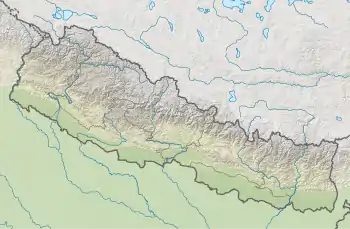| Machapuchare | |
|---|---|
| Machhapuchhre (Fishtail Mountain) | |
 Machapuchare | |
| Highest point | |
| Elevation | 6,993 m (22,943 ft)[1] |
| Prominence | 1,233 m (4,045 ft)[1] |
| Coordinates | 28°29′42″N 83°56′57″E / 28.49500°N 83.94917°E |
| Naming | |
| Native name | कतासुँ क्लिको (Gurung) |
| Geography | |
 Machapuchare Location in Nepal | |
| Location | North Central Nepal |
| Parent range | Annapurna Himalayas |
| Climbing | |
| First ascent | Unclimbed (ascents not allowed) |
Machapuchare, Machhapuchchhre or Machhapuchhre (from Nepali माछापुच्छ्रे 'fishtail', Tamu: कतासुँ क्लिको), is a mountain situated in the Annapurna massif of Gandaki Province, north-central Nepal. Its highest peak has never been officially climbed due to the impossibility of gaining a permit from the government of Nepal.
Location
Machapuchare is at the end of a long spur ridge, coming south out of the main backbone of the Annapurna massif, which forms the eastern boundary of the Annapurna Sanctuary. The peak is about 25 km (16 mi) north of Pokhara, the provincial capital of the Gandaki Province. The sanctuary is a favorite trekking destination, and the site of the base camps for the South Face of Annapurna and many other named and unnamed peaks.
Notable features
Due to its southern position in the range and the particularly low terrain that lies south of the Annapurna Himalayas, which contains three of the 10 highest peaks in the world, Machapuchare commands tremendous vertical relief in a short horizontal distance. This, combined with its steep, pointed profile, makes it a particularly striking peak, despite its lower elevation than some of its neighbors. Its double summit resembles the tail of a fish, hence the name meaning "fish's tail" in Nepalese. It is also nicknamed the "Matterhorn of Nepal".
It is a sacred peak for the Gurungs and the people of Chomrong.[2] The mountain is said to be sacred as a home to the god Shiva.[3][4]
Climbing history

It is believed that Machapuchare has never been climbed to the summit. The only confirmed attempt was in 1957 by a British team led by Lieutenant Colonel Jimmy Roberts. Climbers Wilfrid Noyce and A. D. M. Cox climbed to within 150 m (492 ft) of the summit via the north ridge, to an approximate altitude of 22,793 ft (6,947 m). Adhering to the word of honor given to the then King Mahendra, Noyce and his team descended without stepping on to the summit, and published the only climbing record of the mountain a year later.[5] No permits to climb the mountain have been issued since then.
There are reports of a New Zealand climber, Bill Denz, making a successful yet illegal attempt to reach the summit in the early 1980s.[6]
Sources
- Fanshawe, Andy; Venables, Stephen (1995). Himalaya Alpine Style. Hodder and Stoughton.
- Ohmori, Koichiro (1994). Over The Himalaya. Cloudcap Press/The Mountaineers.
References
- 1 2 "Machapuchare". Peakbagger.com.
- ↑ Vallangi, Neelima. "The Himalayan peak off limits to climbers". www.bbc.com. Retrieved 22 February 2021.
- ↑ Porter, John (2014). One day as a tiger : Alex Macintyre and the birth of light and fast alpinism. Sheffield: Vertebrate Publishing. p. 238. ISBN 978-1-910240-09-0. OCLC 893387833.
- ↑ "Mt. Machhapuchhre: Should it be opened for climbing?". HoneyGuide. 30 July 2015. Retrieved 30 October 2019.
- ↑ Noyce, Wilfrid (1998) [1958]. Climbing the fish's tail. Pilgrims Book House. ISBN 978-8173031007. OCLC 857085947.
- ↑ AnOther (22 July 2016). "The Untouched Holy Mountain of Nepal". AnOther. Retrieved 30 October 2019.
External links
- Machapuchare on Summitpost
- The world's 19 most staggeringly beautiful mountains The Telegraph, April 2018.